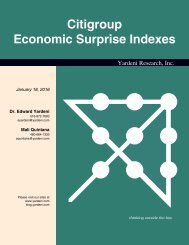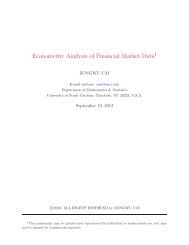Illiquid Asset Investing 1. Liquidating Harvard
Illiquid Asset Investing 1. Liquidating Harvard
Illiquid Asset Investing 1. Liquidating Harvard
You also want an ePaper? Increase the reach of your titles
YUMPU automatically turns print PDFs into web optimized ePapers that Google loves.
Andrew Ang <strong>Illiquid</strong> <strong>Asset</strong> <strong>Investing</strong> <strong>Asset</strong> Management<br />
many properties being reappraised only annually. 15 A good unsmoothing procedure takes<br />
a time-series model that fits the reported return data well and then with a general transfer<br />
function assumption, the filter for true returns in equation (2) becomes a very<br />
complicated function of present and past lagged observed returns. 16 Doing this properly<br />
requires good statistical skills. It also requires underlying economic knowledge of the<br />
structure of the illiquid market to interpret what is a reasonable lag structure, and to judge<br />
how much unsmoothing is required.<br />
Unsmoothed Real Estate Returns<br />
To illustrate the effects of unsmoothing, 17 Figure 3 plots direct real estate returns from the<br />
National Council of Real Estate Investment Fiduciaries (NCREIF), which constructs an<br />
institutional property index from data reported by its members. Because this is an appraisal<br />
index, NCREIF real estate returns are highly autocorrelated. From March, 1978 to December,<br />
2011, the first-order autocorrelation of NCREIF returns is 0.78. The raw reported data is shown<br />
in the solid line. I graph unsmoothed returns in the squares applying the filter of equations (1)<br />
and (2). All returns are at the quarterly frequency.<br />
[Figure 3 here]<br />
Unsmoothing produces a dramatic effect. The minimum reported return during the real estate<br />
downturn in the early 1990s is -5.3% during the quarter ending December 199<strong>1.</strong> The<br />
corresponding unsmoothed return is -22.6%. During the financial crisis, NCREIF returns reached<br />
15 This is noted in the seminal Geltner (1991) and Ross and Zisler (1991) papers.<br />
16 We want an ARMA(p,q) model, which captures the effect of p lagged autocorrelated terms (the “AR” effect for p<br />
lags) and where innovations to those returns in past periods continue to have an effect on present returns. The latter<br />
are referred to as moving average terms (the “MA” effects for q lags). Both Geltner (1991) and Ross and Zisler<br />
(1991) consider richer time-series processes than just an AR(1). Okunev and White (2003) develop unsmoothing<br />
algorithms to hedge fund returns with higher-order autocorrelation corrections.<br />
17 Unsmoothing corrections produce similar effects in other illiquid markets. Campbell (2008), for example,<br />
estimates that unsmoothing increases the volatility of art market returns from 6.5% to 1<strong>1.</strong>5%.<br />
16




